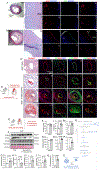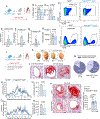Rewiring Endothelial Sphingolipid Metabolism to Favor S1P Over Ceramide Protects From Coronary Atherosclerosis
- PMID: 38456287
- PMCID: PMC11009055
- DOI: 10.1161/CIRCRESAHA.123.323826
Rewiring Endothelial Sphingolipid Metabolism to Favor S1P Over Ceramide Protects From Coronary Atherosclerosis
Abstract
Background: Growing evidence correlated changes in bioactive sphingolipids, particularly S1P (sphingosine-1-phosphate) and ceramides, with coronary artery diseases. Furthermore, specific plasma ceramide species can predict major cardiovascular events. Dysfunction of the endothelium lining lesion-prone areas plays a pivotal role in atherosclerosis. Yet, how sphingolipid metabolism and signaling change and contribute to endothelial dysfunction and atherosclerosis remain poorly understood.
Methods: We used an established model of coronary atherosclerosis in mice, combined with sphingolipidomics, RNA-sequencing, flow cytometry, and immunostaining to investigate the contribution of sphingolipid metabolism and signaling to endothelial cell (EC) activation and dysfunction.
Results: We demonstrated that hemodynamic stress induced an early metabolic rewiring towards endothelial sphingolipid de novo biosynthesis, favoring S1P signaling over ceramides as a protective response. This finding is a paradigm shift from the current belief that ceramide accrual contributes to endothelial dysfunction. The enzyme SPT (serine palmitoyltransferase) commences de novo biosynthesis of sphingolipids and is inhibited by NOGO-B (reticulon-4B), an ER membrane protein. Here, we showed that NOGO-B is upregulated by hemodynamic stress in myocardial EC of ApoE-/- mice and is expressed in the endothelium lining coronary lesions in mice and humans. We demonstrated that mice lacking NOGO-B specifically in EC (Nogo-A/BECKOApoE-/-) were resistant to coronary atherosclerosis development and progression, and mortality. Fibrous cap thickness was significantly increased in Nogo-A/BECKOApoE-/- mice and correlated with reduced necrotic core and macrophage infiltration. Mechanistically, the deletion of NOGO-B in EC sustained the rewiring of sphingolipid metabolism towards S1P, imparting an atheroprotective endothelial transcriptional signature.
Conclusions: These data demonstrated that hemodynamic stress induced a protective rewiring of sphingolipid metabolism, favoring S1P over ceramide. NOGO-B deletion sustained the rewiring of sphingolipid metabolism toward S1P protecting EC from activation under hemodynamic stress and refraining coronary atherosclerosis. These findings also set forth the foundation for sphingolipid-based therapeutics to limit atheroprogression.
Keywords: atherosclerosis; endothelial cells; hemodynamics; macrophages; sphingolipids.
Conflict of interest statement
Figures






References
-
- Tabas I, Williams KJ and Boren J. Subendothelial lipoprotein retention as the initiating process in atherosclerosis: update and therapeutic implications. Circulation. 2007;116:1832–44. - PubMed
-
- Pober JS and Sessa WC. Evolving functions of endothelial cells in inflammation. Nat Rev Immunol. 2007;7:803–15. - PubMed
MeSH terms
Substances
Grants and funding
LinkOut - more resources
Full Text Sources
Medical
Molecular Biology Databases
Miscellaneous

